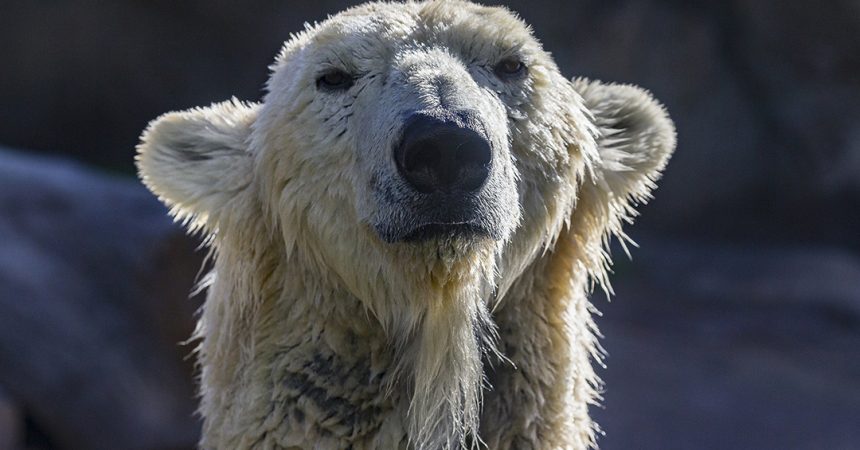Female Bear Prepares to Walk on Treadmill
Tatqiq, a 580-pound polar bear at the San Diego Zoo, is making new strides in her “fitness” training. Animal care staff and scientists at the Zoo’s Institute for Conservation Research have been preparing the 17-year-old female to voluntarily take part in a U.S. Geological Survey (USGS) project that is studying the energy demands polar bears face in the Arctic—an example of the role that zoos play in conservation science.
This week, biologists from the USGS and University of California, Santa Cruz successfully collected data on Tatqiq’s resting oxygen consumption, in preparation for the next phase of the study: walking on a motorized treadmill. “Collecting oxygen consumption (data) gives us a measure of energy expenditure,” said Anthony Pagano, a wildlife biologist with the USGS. “We can use this information to understand what it costs a polar bear to rest—and what that means in terms of the number of seals they need to catch.” Oxygen levels will be linked to data gathered from a collar-mounted accelerometer, which works something like a Fitbit for polar bears. The resulting information will be used to quantify energetic costs and, ultimately, inform conservationists about the impacts of climate change on wild polar bears—especially as their sea ice habitat diminishes.
While inspiring the largest land carnivore to walk on a treadmill may seem difficult, thanks to the efforts of the Zoo’s dedicated animal care staff, Tatqiq has enthusiastically participated. In 2015, she “collaborated” with USGS researchers by wearing an accelerometer collar to track her movements, and the same equipment is being utilized for the treadmill measurements. “Tatqiq regularly participates in our training program, because it’s very stimulating and positive,” said Nate Wagner, a senior keeper at the San Diego Zoo. “She’s a very inquisitive and even-tempered bear, so she’s a great candidate for this study.”
Husbandry training is not only valuable to scientific research, but it also provides an enriching experience for the Zoo’s three polar bears and allows animal care staff to provide the best quality health care.
Since collecting detailed data in remote and extreme Arctic environments is extremely challenging, voluntary participation by polar bears at the San Diego Zoo in studies like this provides scientists with valuable insights into the bears’ daily behavior, movements and energy demands. “We are, first and foremost, a conservation organization,” said Megan Owen, associate director of Applied Animal Ecology at the San Diego Zoo Institute for Conservation Research. “The Zoo is excited to facilitate this conservation study, and Tatqiq’s participation is giving researchers a unique opportunity to study polar bear physiology up close.”
For more than a decade, San Diego Zoo Global’s researchers and its U.S. and Canadian partners have focused on developing conservation strategies to preserve wild populations of polar bears. Today, it is estimated that there are approximately 26,000 polar bears throughout the Arctic. However, climate change from human activity and increases in the length of the ice-free season have caused declines in the number of bears, with subadults having a higher mortality rate than adults.





